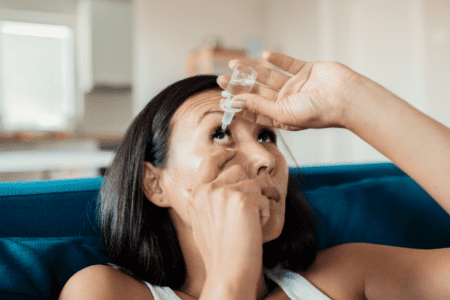 What is dry eyes?
What is dry eyes?- What’s it like to experience dry eyes?
- What causes dry eyes?
- How is dry eyes diagnosed?
- How can I treat dry eyes?
Do you have red eyes that sting or burn? Do they feel gritty and often water? You may have a condition known as dry eyes. While women and people over the age of 50 are more prone to developing dry eyes, anyone can experience the problem. It is a very common condition, and some of the things we do every day can exacerbate the problem, such as staring at your computer screen for long periods.
Somewhere between 16 and 49 million Americans suffer from dry eye disease. What causes dry eyes, how is the condition diagnosed, and most importantly, what treatments are available? We have answers that can help you overcome this uncomfortable condition.
What Is Dry Eyes?
Dry eyes is a condition where the eyes do not produce enough lubrication in the form of tears to stay comfortable and healthy. Every time you blink, the eyelids spread a tear film across the eyes. This moistens and cleans the eye, kind of like the wiper blade on your car. The tear film includes three important layers: oil, water, and mucus.
- The oil layer of your tears is the outside surface of the lubrication that you see when someone is crying. The oil layer is made in the eye’s meibomian gland along the eyelashes on the edge of your eyelid.
- The water layer is the inner part of the tear just behind the oil layer. This section of the tear literally washes away dust and grit that don’t belong in the eye. The water layer is made by a different gland called the lacrimal which is located near your eyebrow above each eye.
- The mucus layer is the innermost portion of each tear. The mucus layer helps tears stick to the eye. It’s manufactured by the conjunctiva, which is the tissue covering the white part of your eye and the insides of your eyelids.
When the tear film is disrupted or the eye doesn’t make enough of this important lubricant, the person is afflicted with the condition known as dry eyes.
What’s It Like to Experience Dry Eyes?
 There are several symptoms that plague people with dry eyes:
There are several symptoms that plague people with dry eyes:
- A gritty scratchiness in the eyes
- Eyes that feel fatigued or bothered by the sun
- Eyes that water more from being irritated and dry all the time
- Burning and stinging
- Blurred vision, especially while reading
- Mucus forming in or around the eyes
- Redness in the whites of the eyes, especially when exposed to wind or smoke
- Pain when wearing contact lenses
If you have dry eyes, you may have one or all of these symptoms. If you’re experiencing symptoms of dry eyes, don’t delay; see your eye doctor. Dry eyes is a chronic and progressive disease that can worsen over time. But what causes a person to experience dry eyes in the first place?
What Causes Dry Eyes?
The normal process of aging can cause dry eyes. As you get older, you tend to make fewer tears, in part due to changes in your body’s hormone production. Women who have gone through menopause are more prone to the disease.
The meibomian gland, which is responsible for producing a healthy oil gland layer in your tears, is often the cause of dry eyes. In fact, 86% of dry eyes cases are tied to meibomian gland dysfunction.
Other medical conditions unrelated to the eye, such as rheumatoid arthritis, disorders of the thyroid or lupus, can cause dry eyes. Medications can also trigger the condition. Antihistamines, which were designed to dry up mucus, can inadvertently affect tear production. Other drugs for serious diseases like high blood pressure or Parkinson’s can also contribute to dry eyes. Refractive eye surgery such as LASIK has been shown to be a contributor, and so have contact lenses.
All of our computer screen time has a negative effect on our eye moisture. When we stare at a screen, we end up blinking less, which means that our eyes are washed less often with the tear film. This is turning out to be a contributor to dry eyes.
How Is Dry Eyes Diagnosed?
The first step toward treatment of your itchy, irritated eyes, is to see your doctor for a comprehensive eye exam. During that visit, your doctor will measure your tear production in a painless test to see both the quality of your tears and the volume you’re producing. There are several tests available including:
- A tear osmolarity test that tracks the composition of your tears
- Special dye tests to measure the surface condition of your eyes
- The Schirmer test to measure the number of tears you produce
These tests and other tests during your comprehensive eye exam will ensure your eyes are otherwise healthy and functioning. If your doctor diagnoses dry eyes, there are several treatments available.
How Can I Treat Dry Eyes?
 If you’re only experiencing mild or occasional dry eyes, an over-the-counter eye drop known as artificial tears may be recommended by your doctor. Warm compresses on the eyes as well as eye massages may help. There are a few preventative measures you can try, including:
If you’re only experiencing mild or occasional dry eyes, an over-the-counter eye drop known as artificial tears may be recommended by your doctor. Warm compresses on the eyes as well as eye massages may help. There are a few preventative measures you can try, including:
- Adding more omega-3 fatty acids like fish, walnuts, and olive oil
- Avoiding hair dryers
- Running an in-room humidifier
- Wearing wrap-around sunglasses when you are outside
Your ophthalmologist may also recommend:
- Prescription eye drop medication that jump starts tear production
- Punctal plugs, which are tiny gel or silicone plugs inserted into the tear ducts to keep the eyes moist
- Surgery designed to permanently close the tear ducts, although this usually isn’t the first recommendation for treatment
If you’re experiencing the symptoms of dry eyes, or if you simply realized it’s been far too long since your last visit to an eye doctor, Jaffe Eye Institute is here to help. We offer the highest quality care to help you see clearly and comfortably for a lifetime.

